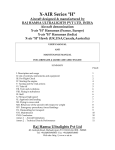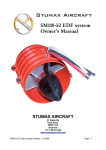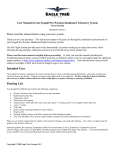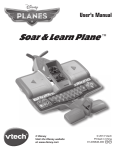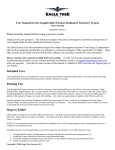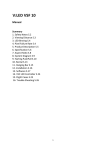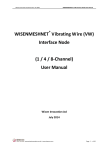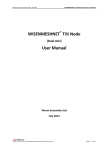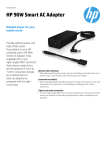Download tcaaqspsr-o-aga-04 - Tanzania Civil Aviation Authority
Transcript
TANZANIA CIVIL AVIATION AUTHORITY Revision: 0 SAFETY REGULATION AERODROMES AND AIR NAVIGATION SERVICES Document No. TCAA/QSP/SR/O/AGA-04 SURVEILLANCE PROGRAMME FOR A CERTIFIED AERODROME Page 1 of 17 1. PURPOSE This order provides guidance to inspectors to carry out surveillance of certified aerodromes to ensure compliance with the requirements in Civil Aviation (Aerodrome) Regulations as amended and other related guidance materials. 2. REFERENCES (i) Civil Aviation (Aerodrome) Regulations as amended (ii) Manual of Aerodrome Standards (iii) ICAO ANNEX 14 Volume I (iv) ICAO Manual on Certification of Aerodrome (Doc 9774) (v) ICAO Safety Management Manual (Doc 9859) (vi) ICAO Airport Service Manual (Doc 9137) (vii) ICAO Aerodrome Design Manual (9157) part 5 electrical system 3. AERODROME INSPECTION OVERVIEW 3.1 Responsibility 3.1.1 Aerodrome Inspection. Aerodrome inspection is a primary responsibility of the aerodrome operating certificate holder. Primary attention should be given to such operational items as pavement areas, safety areas, markings and signs, lighting, aircraft rescue and fire fighting, fuelling operations, navigational aids, ground vehicles, obstructions, public protection, wildlife hazard management, and construction. The responsibility for inspection of all or some of the aerodrome areas may be assigned to other tenants, but with aerodrome management retaining overall inspection supervision. Management cannot delegate responsibility for operating the aerodrome safely. 3.1.2 Inspection Frequency. The frequency of inspections shall be determined by identifying areas critical to the ongoing safety of aircraft operations, taking into account the following factors — a) frequency of aircraft movement duration of operations This is a controlled document Issued October 2010 TANZANIA CIVIL AVIATION AUTHORITY Revision: 0 SAFETY REGULATION AERODROMES AND AIR NAVIGATION SERVICES Document No. TCAA/QSP/SR/O/AGA-04 SURVEILLANCE PROGRAMME FOR A CERTIFIED AERODROME Page 2 of 17 b) types of aircraft served c) the aerodrome environment d) complexity of the facilities e) size of the aerodrome The reasons for establishing the frequency of inspections shall be documented, and submitted to support the contents of the exposition, addressing the certificate holder’s safety inspection programme. 3.1.3 Inspection Recording. An effective aerodrome inspection requires a procedure for reporting deficiencies so that they can be corrected. The aerodrome operator shall notify the Aeronautical Information Service (AIS) (for the issue of a NOTAM), as soon as practicable, of any aerodrome condition or defect which could have an immediate and critical impact on the safety of aircraft operations. When corrective action has been taken, the NOTAM is to be cancelled. For even the smallest aerodrome, it is desirable to use an aerodrome inspection checklist which constitutes a written record of conditions noted, and acts as a check on the follow-up actions taken. The scheduled use of a dated checklist will assure the regularity and thoroughness of safety inspections and follow-up of deficient items. It is most desirable to use a format in which each inspected area of the aerodrome complex is positively noted. 3.2 Knowledge and equipment for aerodrome inspection Personnel who conduct aerodrome inspections shall a) be appropriately qualified Aerodrome and Ground Aids inspectors b) know the location and types of aerodrome facilities and their design criteria; c) know the standards applicable to the aerodrome; d) have a vehicle equipped with — (i) two way voice radio communications with the air traffic services unit, if provided for the aerodrome; This is a controlled document Issued October 2010 TANZANIA CIVIL AVIATION AUTHORITY Revision: 0 SAFETY REGULATION AERODROMES AND AIR NAVIGATION SERVICES Document No. TCAA/QSP/SR/O/AGA-04 SURVEILLANCE PROGRAMME FOR A CERTIFIED AERODROME Page 3 of 17 (ii) a flashing or rotating beacon for night time inspections; and (iii) either a beacon or chequered flag for day time inspections; e) know and use correct radio communication procedures and techniques; f) be supplied with check lists covering the various inspection areas. While the format of check lists vary, it is important to develop a check list that is useful for the aerodrome and its operation. If certain inspectors will be responsible for only certain items, separate check lists pertinent to those areas may be developed. A sketch of the aerodrome should accompany the check list so that the location of problems can be marked for easy identification; g) read the previous inspection report; and h) if construction is in process, be familiar with the safety plan for the project 3.3 Components of an aerodrome inspection An effective safety inspection programme has four components; a) a regularly scheduled inspection of physical facilities b) continuous surveillance of certain aerodrome activities, such as fuelling operations, construction, aerodrome maintenance c) a periodic inspection programme for such things as surveying approach slopes, checking for obstructions, the checking of visual aids, operation of lights d) special inspections during unusual conditions or situations, such as inclement weather or following maintenance activity on the manoeuvring areas. 3. 4 Regularly Scheduled Inspection 3.4.1 Introduction The regularly scheduled inspection consists of specific observations of aerodrome physical facilities on a frequency determined by the aerodrome operator. This inspection should concentrate on the areas described in this section and if deficiencies exist, indicate the item and identify its location on a sketch. Take This is a controlled document Issued October 2010 TANZANIA CIVIL AVIATION AUTHORITY Revision: 0 SAFETY REGULATION AERODROMES AND AIR NAVIGATION SERVICES Document No. TCAA/QSP/SR/O/AGA-04 SURVEILLANCE PROGRAMME FOR A CERTIFIED AERODROME Page 4 of 17 photographs, if appropriate, to document the condition. 3.4.2 Paved Movement Areas The condition of pavement surfaces is an important part of aerodrome safety. Pavement inspection shall be conducted before beginning flight operations to ensure pavement surfaces are clear. As a minimum, a daily inspection shall be performed of all paved areas as follows a) check the pavement edges to assure that they are no greater than necessary to allow water to drain off the pavement. A lip height no greater than 25 mm to 35 mm is usually sufficient to allow proper drainage. Any edge of 75 mm or more would be considered to be a hazard to aircraft b) report and monitor any surface cracking; c) determine if there are any holes. A hole exceeding 125 mm in diameter that exceeds 75 mm in depth with a side slope of 45 degrees or greater, is considered to be a hazard to aircraft and should be dealt with immediately; d) check the condition of pavement areas for scaling, spalling, bumps, low spots, and for debris that could cause damage to aircraft; e) check for vegetation growth along runway and taxiway edges that may impede drainage from the pavement surface or slowly break up the paved surface; and f) check for vegetation growth in cracks. 3.4.3 Unpaved Movement Areas The condition of these surfaces are as important as for paved surfaces and shall should be subject to the same level of thoroughness — a) determine if there are any hazardous ruts, depressions, humps or variations from the normal smooth surfaces; b) determine if there are any holes that could cause directional control problems for any aircraft; c) check for debris and other foreign objects; d) check the condition and length of grass surfaces. The height of the grass should not exceed 20cm ; and This is a controlled document Issued October 2010 TANZANIA CIVIL AVIATION AUTHORITY Revision: 0 SAFETY REGULATION AERODROMES AND AIR NAVIGATION SERVICES Document No. TCAA/QSP/SR/O/AGA-04 SURVEILLANCE PROGRAMME FOR A CERTIFIED AERODROME Page 5 of 17 e) check for vegetation growth along the edges that may impede drainage from the movement areas. 3.4.4 Runway and taxiway strips and safety areas The inspector must know the dimensions of the runway and taxiway strips and runway end safety areas at the aerodrome and: a) determine if there are any hazardous ruts, depressions, humps or variations from the normal smooth surface; b) check to ensure no object is located in these areas, except objects that must be in the areas because of their functions (such as runway lights, signs, or navigational aids); c) determine if the base for any equipment in safety areas is at grade level; d) check to ensure that the ground has not been eroded from around light bases, manhole covers, or other fittings that should be flush with the surface; and an exposed high edge could be a hazard to aircraft and should be filled in. e) check for any damage that might be caused by wildlife 3.4.5 Markings and signs Aerodrome markings and signs provide important information to pilots during take-off, landing and taxiing. The inspector should know the appropriate markings and signs at the aerodrome: a) check markings for correct colour coding, blistering, chipping, fading, and obscurity due to rubber build-up; b) check that markers are correctly positioned and in good condition; c) check signs to ensure they are the correct colour coding, easy to read, secure, and that all lights are working and not obscured by vegetation or dirt; d) check that signs within the strip areas are frangibly mounted; and e) check to see that signs are not missing, that they have the correct legend and This is a controlled document Issued October 2010 TANZANIA CIVIL AVIATION AUTHORITY Revision: 0 SAFETY REGULATION AERODROMES AND AIR NAVIGATION SERVICES Document No. TCAA/QSP/SR/O/AGA-04 SURVEILLANCE PROGRAMME FOR A CERTIFIED AERODROME Page 6 of 17 orientation, and whether they are in need of repair. 3.4.6 Lighting At night and during periods of low visibility, lighting is important for safe aerodrome operations. Lights come in different shapes, sizes, colours, and configurations and can be flush mounted or elevated: a) check to ensure that the following are operable, if installed, and that the optical systems are not obscured by vegetation or deposits of foreign material :-(i) runway threshold and end lights (ii) runway, taxiway, and apron edge lights (iii) runway centreline and touchdown zone lights (iv) taxiway centreline lights and apron guidance lights (v) holding position lights (vi) runway end identifier lights, if installed (vii) reflectors (viii) floodlights for signs (ix) visual docking systems (x) apron floodlighting (xi) obstruction lights b) report all damaged or missing fixtures, and lights that are not working; c) report any broken lenses; d) ensure that runway and taxiway lights and runway threshold lights are the proper colour and are oriented correctly; and e) check that lights function properly, including intensity controls, through the manual or radio control features, and that photocell controls function properly. 3.4.7 Visual navigation aids This is a controlled document Issued October 2010 TANZANIA CIVIL AVIATION AUTHORITY Revision: 0 SAFETY REGULATION AERODROMES AND AIR NAVIGATION SERVICES Document No. TCAA/QSP/SR/O/AGA-04 SURVEILLANCE PROGRAMME FOR A CERTIFIED AERODROME Page 7 of 17 The inspection shall concentrate on the visual navigational aids as follows: a) ensure that the windsock area is clear of vegetation and that it can be easily seen; b) check the windsock to ensure that the supporting mast is upright, that the windsock swings freely and, if lighted, that all lights are operating; c) ensure that the aerodrome beacon, if provided, is visible and working properly; d) ensure if installed that the Runway End Identifier Lights (REIL) are flashing, and not obscured to an approaching aircraft; and e) check Visual Glide Slope Indicators (VASIS, PAPI) to ensure that their lights are working, not obscured to an approaching aircraft and that the mountings have not been damaged or disturbed. 3.4.8 Obstructions The inspection shall concentrate on a visual check of any construction underway on or near the aerodrome that could affect aircraft operations: a) check for any new or unreported obstructions such as cranes, masts, advertising hoardings, balloons and suchlike, that intrude into the aerodrome obstacle free surfaces; and b) determine that obstructions are properly marked and lit. 3.4.9 Construction The inspection shall focus on construction activities on the aerodrome to ensure that a high level of safety for aircraft operations is maintained: a) determine if stockpiled material and construction materials are properly stored to keep them from being moved by wind, jet blast, or propwash; b) check all construction adjacent to movement areas to ensure areas are identified with conspicuous marking and lighting; This is a controlled document Issued October 2010 TANZANIA CIVIL AVIATION AUTHORITY Revision: 0 SAFETY REGULATION AERODROMES AND AIR NAVIGATION SERVICES Document No. TCAA/QSP/SR/O/AGA-04 SURVEILLANCE PROGRAMME FOR A CERTIFIED AERODROME Page 8 of 17 c) determine if heavy construction equipment (such as bulldozers and cranes) are marked and lighted and parked clear of the runway and taxiway strips and any safety areas; d) check to determine that stockpiles and stored equipment are not left in a position that would infringe the obstacle free surfaces; and e) check to ensure that debris and foreign objects are progressively being picked up around construction areas. 3.4.10 Aircraft rescue and fire fighting The inspection shall focus, if rescue and fire fighting is required, on the rescue fire fighting capability as follows — a) at applicable aerodromes, check aircraft rescue and fire fighting equipment availability; b) determine that all required rescue and fire fighting vehicles are serviceable and the required personnel are available; c) insure communication systems are working; and d) determine the adequacy of the fire fighting agents on hand. 3.4.11 Public protection Check the serviceability of barriers provided for public protection and the functioning of any control procedures. 3.4.12 Wildlife hazard management Check for dead birds or animals on the runways, taxiways, and aprons or other signs that wildlife problems may be developing — such as large flocks of birds on or adjacent to the aerodrome. 3.5 Continuous Surveillance 3.5.1 Introduction This is a controlled document Issued October 2010 TANZANIA CIVIL AVIATION AUTHORITY Revision: 0 SAFETY REGULATION AERODROMES AND AIR NAVIGATION SERVICES Document No. TCAA/QSP/SR/O/AGA-04 SURVEILLANCE PROGRAMME FOR A CERTIFIED AERODROME Page 9 of 17 Continuous surveillance is an alertness practised by personnel to look for defects at any time they are on the aerodrome operational area. Continuous surveillance of aerodrome physical facilities and activities should cover at least the areas described in this section. 3.5.2 Ground vehicles a) Determine if procedures and arrangements for the orderly operations of ground vehicles (including grass mowing machines) are being followed; and b) Report any deficiencies, if appropriate. 3.5.3 Construction a) Check for unauthorised use of runways, taxiways, and aprons by construction personnel and equipment; b) Look out for potential runway incursions and other irregularities; c) Check all construction projects to ensure that the safety plan is being followed by the contractor; and d) Ensure that construction equipment is not operated in navigational aid critical areas unless it is coordinated with the operator of the aid. 3.5.4 Public protection a) Be alert for unauthorised persons, vehicles, and animals; and b) Ensure gates are serviceable and clear for access by rescue and fire fighting vehicles. 3.5.5 Wildlife hazard management a) Note any birds or animals on or adjacent to the runways, taxiways, and aprons, to determine if there is a potential wildlife hazard problem; and b) Report any potential hazard created by birds on or adjacent to the aerodrome. This is a controlled document Issued October 2010 TANZANIA CIVIL AVIATION AUTHORITY Revision: 0 SAFETY REGULATION AERODROMES AND AIR NAVIGATION SERVICES Document No. TCAA/QSP/SR/O/AGA-04 SURVEILLANCE PROGRAMME FOR A CERTIFIED AERODROME Page 10 of 17 3.5.6 Potential problems Check the following for any potential problems — a) control of pedestrian access to the movement areas; b) passenger loading and off-loading areas; c) other movement areas frequented by the general public; and d) debris on movement areas. 3.6 PERIODIC CONDITION EVALUATION 3.6.1 Introduction Periodic condition evaluations consist of specific checks on a regularly scheduled basis (but less frequently than daily). Checks may require use of specialist equipment and should cover at least the areas described in this section. 3.6.2 Pavement areas Check pavement surfaces for rubber build-up, polishing, or other conditions affecting surface friction. 3.6.3 Markings and signs a) Check pavement markings to ensure that they comply with standards and in good condition; and b) Determine if markings are visible at night, especially examine for rubber build-up in the touchdown zone areas. 3.6.4 Visual navigational aids An inspection programme for each visual navigation aid is essential to confirm their ongoing accuracy and reliability — a) visual navigation aids inspections shall include regular checks of the power This is a controlled document Issued October 2010 TANZANIA CIVIL AVIATION AUTHORITY Revision: 0 SAFETY REGULATION AERODROMES AND AIR NAVIGATION SERVICES Document No. TCAA/QSP/SR/O/AGA-04 SURVEILLANCE PROGRAMME FOR A CERTIFIED AERODROME Page 11 of 17 supply, light emission and alignment using such equipment as a spotmeter and aiming at calibration bars; b) ensure that power generator and circuit resistance tests are being conducted; c) ensure that operation on auxiliary power will cause no deterioration in any aspect of the lighting systems and that the time to cut in does not exceed 15 seconds; and d) for the flight checking of visual aids. 3.6.5 Obstacles a) If the aerodrome is required to provide the AIS with data for the promulgation of aerodrome obstacle charts, survey all take-off flight paths to confirm the accuracy of the data; b) Survey the other aerodrome obstacle limitation surfaces established for the aerodrome for clearance from protruding obstacles; c) If an obstruction is found to infringe an obstacle limitation surface, either immediately remove the obstruction or notify the AIS with the corrected effective operational lengths (EOL) for promulgation in a NOTAM. If the infringing obstruction is permanent, notify the AIS of the permanent EOL for promulgation in the AIP; and d) The period for the conduct of the checks should be determined, and included in the aerodrome operating exposition, by a study of the aerodrome environment to identify the likelihood of significant obstructions, such as tree growth, structures, and similar, being developed in the intervening periods. 3.7 Special Inspections 3.7.1 Introduction Special inspections occur after receipt of a complaint such as substandard braking action, or as triggered by an unusual condition or event. A special inspection shall be conducted after an accident or incident. Depending upon circumstances, special inspections may include the inspection of any of the specific facilities or activities This is a controlled document Issued October 2010 TANZANIA CIVIL AVIATION AUTHORITY Revision: 0 SAFETY REGULATION AERODROMES AND AIR NAVIGATION SERVICES Document No. TCAA/QSP/SR/O/AGA-04 SURVEILLANCE PROGRAMME FOR A CERTIFIED AERODROME Page 12 of 17 under the other three components. A special inspection shall cover at least the areas described in this section. 3.7.2 Paved movement areas After heavy precipitation an inspection and assessment should be made as follows: 3.7.3 Water on a runway Whenever water is present on a runway, a description of the runway surface conditions on the centre half of the width of the runway, including the possible assessment of water depth, where applicable, should be made available using the following terms: DAMP - the surface shows a change of colour due to moisture. WET - the surface is soaked but there is no standing water. WATER PATCHES - significant patches of standing water are visible. FLOODED - extensive standing water is visible. 3.7.4 Unpaved movement areas After or during a period of heavy precipitation, check for ponding, and any surface softness which might affect the bearing strength and braking. 3.7.5 Runway and taxiway strips and safety areas a) check storm water system to verify that inlets are not clogged and drainage channels are free of debris. Note any standing water; and b) ensure all drain covers are in place and flush with the surface. 3.7.6 Maintenance and construction a) conduct a special inspection before reopening a runway or taxiway following any construction or maintenance that has been performed in or around the manoeuvring area; This is a controlled document Issued October 2010 TANZANIA CIVIL AVIATION AUTHORITY Revision: 0 SAFETY REGULATION AERODROMES AND AIR NAVIGATION SERVICES Document No. TCAA/QSP/SR/O/AGA-04 SURVEILLANCE PROGRAMME FOR A CERTIFIED AERODROME Page 13 of 17 b) any time an aircraft has left the pavement and entered a strip or safety area check to ensure that no ruts or holes have been made by the aircraft tires or personnel and equipment during the recovery operation; c) check for construction and maintenance activities to ensure that no hazardous conditions have been created (equipment left in safety areas, unacceptable pavement edges created by ground alteration work, ruts from mowing equipment); and d) after construction or maintenance operations, ensure that pavement markings are correct and that any unserviceable markers have been removed. 4.0 FLIGHT CHECKING OF VISUAL AIDS 4.1 Introduction The objective for the flight checking of visual aid lights is to ascertain their accuracy and intensity provided by the visual approach aids and to otherwise determine the conspicuity of all the lights required for air navigation at an aerodrome. Flight checking is not a means for determining the serviceability of lights and visual aids as this is best done by an effective aerodrome inspection, and preventive maintenance programme as mentioned earlier in Chapter 4. The requirements for ongoing flight checking can also be minimised by such programmes. 4.2 Requirements for specific flight checking Visual aids include markings, wind direction indicators and the like. Visual aids and aerodrome lights, other than taxiway and apron lights, shall be flight checked in the following circumstances: a) prior to commissioning into service; and when any major component is replaced with re-alignment or re-siting required; and b) c) when any visual aid is re-sited; and d) periodically to confirm ongoing performance. This is a controlled document Issued October 2010 TANZANIA CIVIL AVIATION AUTHORITY Revision: 0 SAFETY REGULATION AERODROMES AND AIR NAVIGATION SERVICES Document No. TCAA/QSP/SR/O/AGA-04 SURVEILLANCE PROGRAMME FOR A CERTIFIED AERODROME Page 14 of 17 4.3 Flight checking criteria Approach slope indicators shall be flight checked to confirm that each aid provides accurate guidance within the tolerances prescribed for that aid. All other visual aid lighting shall be flight checked to verify the appearance, uniformity, intensities of the light and that there is no visual interference by any other light or object. The visual aid lighting performance characteristics to be verified by flight checking prior to being commissioned into service should be: PAPI’s a) (i) Appearance and uniformity (ii) Channel width, glide path angle and ILS/PAR coincidence (iii) Top of red crossbar (iv) Day and night angular coverage (v) Cut off light 1 (vi) Top of red light 1 and obstruction clearance (vii) Cut in light 6 (viii) Range day and night, intensities and auxiliary power b) Other VASIS (i) Appearance and uniformity (ii) Channel width, glide path angle and ILS/PAR coincidence (iii) Day and night angular coverage (iv) Obstruction clearance This is a controlled document Issued October 2010 TANZANIA CIVIL AVIATION AUTHORITY Revision: 0 SAFETY REGULATION AERODROMES AND AIR NAVIGATION SERVICES Document No. TCAA/QSP/SR/O/AGA-04 SURVEILLANCE PROGRAMME FOR A CERTIFIED AERODROME Page 15 of 17 5.0 AERODROME CONDITION NOTIFICATION 5.1 Introduction Under Civil Aviation (Aerodrome) Regulations as amended, each holder of an aerodrome operating certificate is required to provide information on any conditions which might affect the safe operations of aircraft. Information on the condition of the movement area and the operational status of related facilities shall be notified to the AIS. The local air traffic service unit shall also be notified to enable them to provide the information to arriving and departing aircraft. The information shall be kept up to date and changes in condition reported without delay. 5.2 NOTAM Each holder of an aerodrome operating certificate shall ensure that if unsafe conditions are uncovered as a result of aerodrome inspections, or from any other source, and cannot be immediately rectified, appropriate NOTAM are issued and that local aerodrome users are aware of the situation. After providing the information to the AIS, follow up to ensure that the NOTAM were issued. Once a NOTAM has been issued it is the responsibility of the aerodrome operator to monitor the reported condition and to either update the NOTAM information or cancel the NOTAM if the condition has been rectified. Information The information provided for the issue of NOTAM shall be clear and precise and shall contain: a. type of unserviceability or unsafe condition; b. extent (area) of the unserviceability or condition; and c. duration (expected length of time) the condition will remain. It is important that the area in which the unserviceability or unsafe condition occurs is referred to correctly. Runways and runway strips should be referred to by their runway designator rather than the “long” or “main strip”. Similarly the difference between the runways and runway strips should be recognised and the correct terminology used. This is a controlled document Issued October 2010 TANZANIA CIVIL AVIATION AUTHORITY Revision: 0 SAFETY REGULATION AERODROMES AND AIR NAVIGATION SERVICES Document No. TCAA/QSP/SR/O/AGA-04 SURVEILLANCE PROGRAMME FOR A CERTIFIED AERODROME Page 16 of 17 In complying with Civil Aviation (Aerodrome) Regulations the holder of an aerodrome operating certificate shall provide information to the AIS for the issuance of a NOTAM on any of the following aerodrome conditions which may affect the safe operations of aircraft — a) establishment, closure or significant changes in the operation of the aerodrome or runways; b) establishment, withdrawal or significant changes made to visual aids; c) interruption of, or return to operation of major components of the aerodrome lighting systems; d) occurrence, or correction of major defects or impediments in the manoeuvring areas; e) changes to and limitations on availability of fuel, oil and oxygen (International aerodromes); f) establishment, withdrawal or return to operation of hazard beacons marking significant obstacle to air navigation; g) erecting, removal of or changes to significant obstacles to air navigation in the take-off, climb, missed approach, approach areas, and runway strip; h) significant changes in the level of rescue and fire fighting protection normally provided at the aerodrome; i) presence or removal of significant changes in hazardous conditions due to snow, slush, ice or water on the movement area; and j) any other occurrence associated with the aerodrome which might be a hazard to the safety of aircraft operations. __________________________ Tanzania Civil Aviation Authority This is a controlled document Issued October 2010 TANZANIA CIVIL AVIATION AUTHORITY Revision: 0 SAFETY REGULATION AERODROMES AND AIR NAVIGATION SERVICES Document No. TCAA/QSP/SR/O/AGA-04 SURVEILLANCE PROGRAMME FOR A CERTIFIED AERODROME Page 17 of 17 This is a controlled document Issued October 2010




















